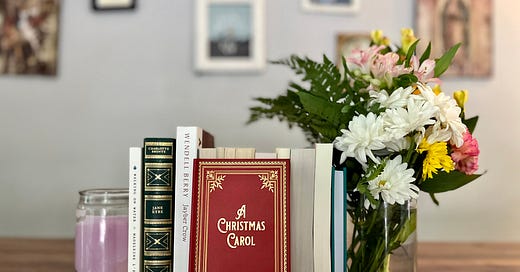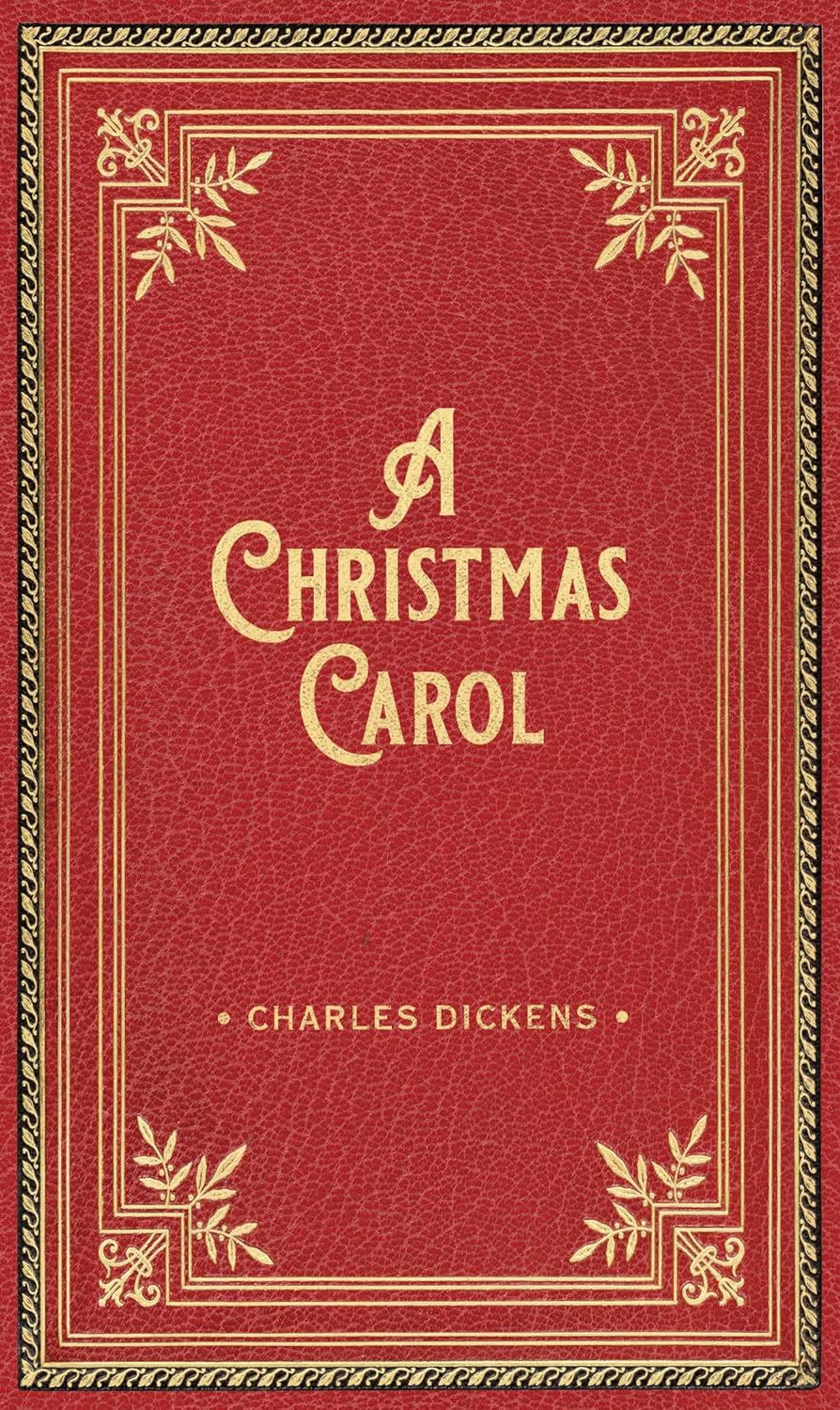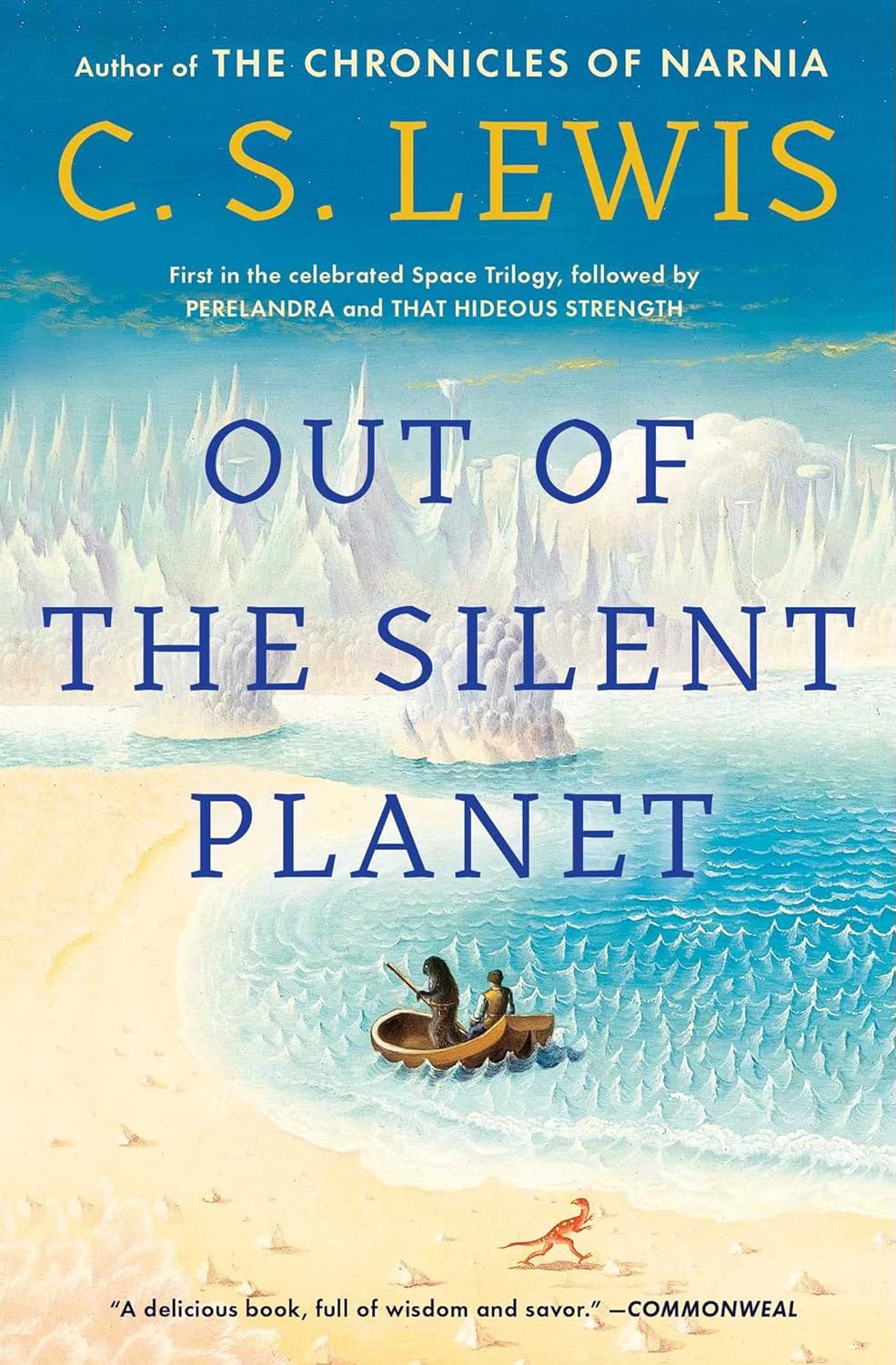Welcome to Reading Revisited, a place for friends to enjoy some good old-fashioned book chat while revisiting the truth, beauty, and goodness we’ve found in our favorite books.
Happy mid-November, readers!
Picking up this story this week is really ushering in the reality that the holiday-season-marathon is fast approaching! One thing that A Christmas Carol does well is to call to mind, (if you’ll forgive me the cliché), the magic of the Christmas season. As the “mother-behind-the-magic” of my home, this read is inspiring me to invite my kids into the joy we begin to approach throughout Advent and into Christmastide. So even if, like me, you’re picking up this story a bit earlier than usual, I hope it serves as a good reminder that the extra service we take up for our families and loved ones this time of year is lovely and important work.
As we begin to dive into this story, I’ll your draw your attention to the preface. Whenever an author addresses us directly and states his intentions, it is worth keeping in our mind as we read:
“I have endeavored in this Ghostly little book, to raise the Ghost of an Idea, which shall not put my readers out of humor with themselves, with each other, with the season, or with me. May it haunt their houses pleasantly, and no one wish to lay it.” (preface)
I plan to keep our posts on this book short and sweet since I’ll just be covering one chapter at a time! Here are some things I noticed from this first chapter:
Dickens is a master of opening a story. Truthfully, the entire first page of this little book is worth commonplacing, but I’ll limit myself to pointing out, some un-missable lines from the opening page:
“Marley was dead: to begin with. There is no doubt whatever about that…Old Marley was as dead as a door-nail…
Mind! I don’t mean to say that I know, of my own knowledge, what there is particularly dead about a door-nail. I might have been inclined, myself, to regard a coffin-nail as the deadest piece of ironmongery in the trade. But the wisdom of our ancestors is in the simile; and my unhallowed hands shall not disturb it, or the Country’s done for…
There is no doubt that Marley was dead. This must be distinctly understood, or nothing wonderful can come of the story I am going to relate.”
In addition to serving as a pithy and extremely amusing launch into Scrooge’s story, Dickens is also establishing the form and tone of the narrative. This is a ghost story. Lest we, like Scrooge upon encountering his first visitor, want to rationalize or demystify, we must remember the injunction: Marley was dead: to begin with.
Another sign as to the form of the story comes right after some long introductory remarks re: Scrooge’s character. At the bottom of page 3 (in my edition), Dickens opens the action of the story with the fairy-tale opening:
“Once upon a time — of all the good days of the year, on Christmas Eve…” (p. 3)
I’ll definitely be keeping my eye out for some fairy-tale tropes and traditions throughout the story!
Earlier on page 3, while describing Scrooge, we read:
“Nobody ever stopped him in the street to say, with gladsome looks, “My dear Scrooge, how are you? when will you come to see me?” No beggars implored him to bestow a trifle, no children asked him what it was o’clock, no man or woman ever once in all his life inquired the way to such and such a place of Scrooge.” (p. 3)
This little quote is full of foreshadowing. Within the first few pages of our narrative, we see Scrooge be invited to visit his nephew, Fred, AND we see two gentlemen enter the counting house to ask Scrooge for a donation. I don’t think it’s a coincidence that these occurrences are two of the things that never happen to Scrooge, so I am keeping my eyes open to see how other encounters he has challenge the way he typically interacts.
The characterization of Scrooge is worth paying attention to. Throughout the Dickensian canon are many Scrooge-like characters, obsessed by their ever-growing wealth. Dickens indicts Scrooge, the miser, not solely for his great wealth, but for his failing to, even selfishly, use his money to improve his life. Scrooge eats “a melancholy dinner”, lives in “a gloomy suite of rooms”, sits by “a very low fire indeed.”
As Scrooge returns home and encounters several unsettling phenomena, we see a battle between his rationalistic mind and his imagination. He quickly dismisses what he has seen as ridiculous, yet takes the time to check his rooms and double-lock the door. This leads us to the bell! The ringing of the bell is extremely important. Not only is the sound of religious significance (i.e the bells to signify the presence of Christ in the Eucharist in the Catholic tradition), but bells were also used to announce the presence of spirits in a “seance” or spiritualist experience (which were all the rage in Dickens’ time), so we ought not be surprised at the appearance of Marley’s ghost being ushered in by the ringing.
I love the dialogue between Scrooge and Marley’s ghost. Scrooge again tries to dispel his fright with his rationality, and Marley’s ghost does not plead or reason with him, his response is simply to show forth his full ghostly self, and the horror Scrooge undergoes is enough to convince him:
“At this the spirit raised a frightful cry, and shook its chain with such a dismal and appalling noise that Scrooge held on tight to his chair, to save himself from falling in a swoon. But how much greater was his horror, when the phantom taking off the bandage round its head, as if it were too warm to wear in-doors, its lower jaw dropped down upon its breast!
Scrooge fell upon his knees, and clasped his hands before his face.” (p.20)
Marley’s ghost points out that Scrooge himself bears a chain longer and heavier than his own, and makes it clear that the spirit longs to help him. This longing to help, to give, is what characterizes the lonely and suffering journey of Marley’s ghost:
“It is required of every man, that the spirit within him should walk abroad among his fellow-men…and if that spirit goes not forth in life, it is condemned to do so after death…It is doomed to wander through the world…and witness what it cannot share, but might have shared on earth, and turned to happiness.” (p. 21)
After warning Scrooge of his forthcoming ghostly visitors, Marley’s ghost departs. Scrooge sees, through the window, as though a veil were lifted, the night filled with chain-bearing phantoms:
“The misery with them all was, clearly, that they sought to interfere, for good, in human matters, and had lost the power for ever.” (p. 25)
Upon bearing witness to this tragic sight, Scrooge attempts to blow it off with his usual, “Humbug!”, but the word dies on his lips. Scrooge cannot yet admit the great change that is beginning within him after what he has seen and heard, but already he is not the same.
Themes to keep an eye on:
Scrooge’s identity. The fact that Scrooge continues to operate his business under “Scrooge and Marley”, lives in rooms that once belonged to his deceased partner, and even “answered to both names” is interesting. He seems to operate his business with the same aloof anonymity with which he conducts the rest of his life. How Scrooge is viewed by himself and others is going to be an interesting thing to keep an eye on throughout the remainder of the story.
Temperature: how characters respond to the external weather (i.e with vulnerability like Bob Cratchit or with impenetrability like Scrooge) is something that is pointed out often in this chapter.
“External heat and cold had little influence on Scrooge. No warmth could warm, no wintry weather chill him.” (p. 3)
Sight vs. Obscurity: we see in this section lots of fog, darkness, and inability to see clearly.
“The fog came pouring in at every chink and keyhole, and was so dense without, that although the court was of the narrowest, the houses opposite were mere phantoms.” (p. 4)
Childlikeness/Treatment of Children: As the lovely
pointed out on this week’s podcast episode, Dickens often plays with the theme of childlikeness and draws attention to how various characters interact with children. I love especially the playfulness of Bob Cratchit:“the clerk, with the long ends of his white comforter dangling below his waist, went down a slide on Cornhill…twenty times in honor of its being Christmas Eve, and then ran home to Camden Town as hard as he could pelt, to play at blindman’s bluff.” (p.12)
As we move forward into the coming chapters, I’m watching to see how these themes unfold more fully. I hope you’ve all enjoyed this section as much as I have, stay tuned for the Stave 2 read-along guide later this week!
Until next time, keep revisiting the good books that enrich your life and nourish your soul.
In Case You Missed It:
Reading Revisited ep. 26: Intro to Dickens and A Chrismas Carol with
What We’re Reading Now:
December
A Christmas Carol by Charles Dickens
January
Othello by William Shakespeare
February
Out of the Silent Planet AND Perelandra by C.S. Lewis
A Few Reminders:
If you are wanting to get in on the in person or virtual community please contact us!
We have turned on paid subscriptions which will allow you to support the work we are doing here as well as receive Read Along Guide PDFs each month, voice recordings of the Read Along Guides and Essays, and we are working on (printable) bookmarks for each book.
If you would like to make a small contribution to the work we’re doing here at Reading Revisited, we invite you to do so with the Buy (Us) a Coffee button below. We so appreciate your support!
*As always, some of the links are affiliate links. If you don’t have the books yet and are planning to buy them, we appreciate you using the links. The few cents earned with each purchase you make after clicking links (at no extra cost to you) goes toward the time and effort it takes to keep Reading Revisited running and we appreciate it!
Keep reading with a 7-day free trial
Subscribe to Reading Revisited to keep reading this post and get 7 days of free access to the full post archives.









